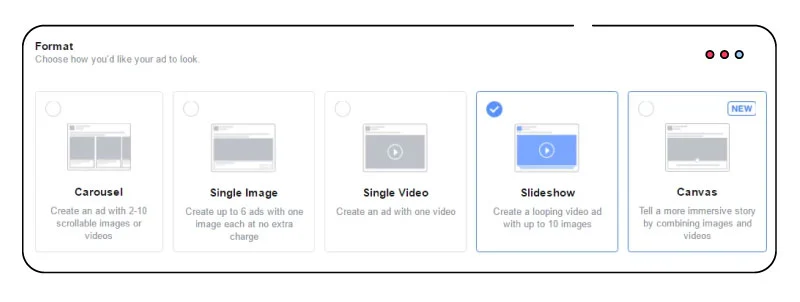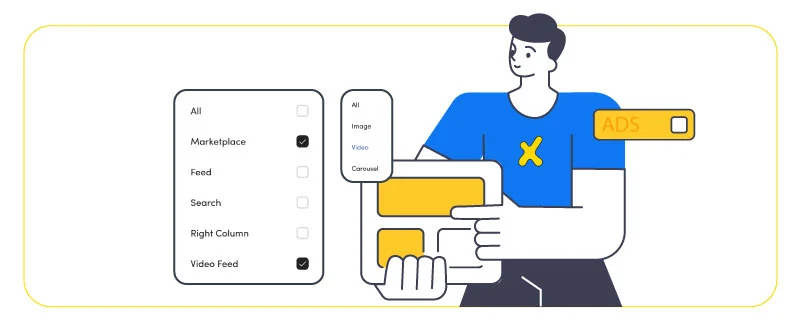Facebook Ads are now a cornerstone of digital marketing, enabling businesses to reach a vast audience on the world’s largest social media platform. With a variety of ad formats and placements, Facebook allows advertisers to craft compelling ad campaigns.

It is essential to understand how to effectively use Facebook Ads formats and placements to achieve maximum impact and ROI for your advertising budget. Facebook Ad Formats play a crucial role in the success of advertising campaigns on the social media platform. With its massive user base and diverse targeting options, Facebook offers various ad formats that cater to different business objectives and target audiences. Understanding these ad formats is essential for advertisers to create impactful and engaging content that resonates with their target audience. In this article, we will explore Facebook Ads formats and placements, their significance in digital marketing, and best practices for utilizing them effectively.
Facebook Ad Formats: Overview and Explanation
To effectively use Facebook Ads, it’s important to understand the different ad formats available. Here’s an overview of the Facebook Ad Formats:
- Image Ads: As mentioned, these are simple and effective, and can be created quickly and easily. With an eye-catching image and a short caption, you can quickly grab the attention of your target audience. However, it’s important to note that the image should be high quality and relevant to the product or service being advertised.
- Video Ads: Video Ads offer a more immersive and engaging experience for users. You can tell a story, showcase your product or service in action, or feature customer testimonials. It’s important to keep in mind that videos should be short and to the point, with a clear message and call to action.
- Carousel Ads: With Carousel Ads, you can showcase multiple products or features within a single ad. This format is ideal for businesses with a range of products or services to promote. It’s important to note that each image or video within the carousel should be high quality and relevant to the target audience.
- Slideshow Ads: Slideshow Ads are similar to video ads but are created from a series of still images. This format can be an affordable option for businesses with limited budgets as it requires less time and resources to create. It’s important to note that the images should be high quality and relevant to the target audience.
- Collection Ads: Collection Ads are designed for mobile users and allow them to browse through your products or services within the Facebook app, without being redirected to your website. This format is ideal for businesses with a large inventory of products as it allows for easy browsing and purchasing.
- Instant Experience Ads: Instant Experience Ads provide an immersive and interactive experience for users with full-screen videos and images that can be swiped and scrolled through. This format is ideal for businesses with a visually stunning product or service to promote. It’s important to keep in mind that the experience should be optimized for mobile users and should have a clear call to action.

Understanding each of these ad formats can help you choose the best one for your business and ensure that your ads are effective.
It’s important to note that the success of your Facebook Ads is not only dependent on the ad format but also on other factors such as targeting, bidding strategy, and ad placement. Before launching your ad campaign, it’s crucial to define your target audience, set a budget, and choose the appropriate ad placement.
Targeting your ads to the right audience is essential to maximize your ad’s effectiveness. Facebook provides a range of targeting options, including demographics, interests, behaviors, and even custom audiences. By defining your target audience, you can ensure that your ad is seen by the right people, increasing the chances of conversion.
Bidding strategy is another crucial factor in determining the success of your Facebook Ads. You can choose from different bidding options, including cost per click (CPC), cost per impression (CPM), and cost per action (CPA). Each bidding option has its own pros and cons, and the best option will depend on your campaign objectives and budget.
Finally, choosing the right ad placement is essential to ensure that your ad is seen by your target audience. As discussed earlier, Facebook offers a range of ad placements, and each has its own unique advantages and considerations. It’s important to select the placement that aligns with your campaign objectives and target audience.
By understanding and optimizing these factors, you can create effective Facebook Ads that drive engagement, conversion, and revenue for your business.
Facebook Ad Placements and Their Details
Facebook Ad Placements refer to the specific locations within the Facebook platform where ads can be displayed. Advertisers can choose from a variety of placements based on their campaign goals and target audience. Here is an overview of the different Facebook Ad Placements:
- Feeds: Ads appear within a user’s News Feed, either as sponsored posts or in between organic posts.
- Stories: Ads appear as full-screen vertical videos or images within Facebook or Instagram Stories.
- In-Stream Videos: Ads appear within videos on Facebook Watch, Live, or News Feed.
- Search Results: Ads appear in search results when users search for specific keywords or phrases.
- Marketplace: Ads appear in the Marketplace section, where users can buy and sell goods.
- Audience Network: Ads appear on third-party websites and apps that are part of Facebook’s Audience Network.

Each placement has its own unique advantages and considerations. For example, In-Stream Videos may be more effective for increasing brand awareness, while Marketplace ads may be more effective for driving direct sales. Advertisers should consider their campaign objectives and target audience when selecting their ad placements.
Choosing the Right Facebook Ad Format and Placement
When it comes to creating Facebook ads, choosing the right format and placement is crucial for the success of the campaign. The objective of the ad should be clearly defined, whether it’s to increase brand awareness, drive traffic to a website, or generate leads. This will help determine which format and placement will be most effective in achieving the desired goal.
The target audience should also be taken into consideration when choosing the format and placement. Different formats and placements will appeal to different audiences, and it’s important to choose the one that is most likely to resonate with the target demographic. For example, younger audiences may be more likely to engage with Stories ads, while older audiences may prefer ads in the News Feed.

Budget is another important factor to consider when choosing the right format and placement for a Facebook ad. Some formats and placements may be more expensive than others, and it’s important to choose one that fits within the allocated budget.
Finally, the type of business should also be considered when selecting the right format and placement. A B2B company may find that ads in the News Feed or In-Stream Videos are more effective, while a B2C company may have more success with Carousel Ads or Collection Ads.
Overall, selecting the right Facebook ad format and placement is crucial for the success of the campaign, and careful consideration should be given to the objective of the ad, target audience, budget, and type of business.
Best Practices for Facebook Ad Formats and Placements
Here are some Facebook ad tips and best practices for both ad formats and placements:
- Use eye-catching visuals: Whether you’re using an image or video ad, make sure that the visuals are high-quality, attention-grabbing, and relevant to your target audience.
- Keep your copy concise: Use clear and concise messaging to convey your value proposition and grab the attention of your audience. Avoid using jargon and complex language.
- Optimize for mobile: With most Facebook users accessing the platform on their mobile devices, it’s important to optimize your ads for mobile screens.
- Test and iterate: Experiment with different ad formats and placements, test your messaging and visuals, and make data-driven decisions to optimize your campaigns.
- Use targeting wisely: Take advantage of Facebook’s targeting options to reach your ideal audience. Consider factors such as age, gender, location, interests, and behaviors when setting up your targeting.
- Monitor and optimize: Measuring Facebook ad performance and making adjustments as needed is a must. Continuously optimizing your campaigns based on data insights can help you achieve better results.

By following these best practices, you can create effective Facebook Ads and optimize your campaigns for success. An effective practice you could try is taking advantage of a Facebook Ads spy tool to check out how successful advertisers are handling their campaigns and copy, creative, and targeting properties yield the best results in your niche.
Conclusion
In conclusion, Facebook Ads are a powerful tool for businesses to reach their target audience effectively. By choosing the right format and placement based on the objective of the ad, target audience, budget, and type of business, advertisers can optimize their Facebook Ad Campaigns. Best practices for creating effective Facebook Ads include using high-quality visuals, creating engaging ad copy, and targeting the right audience. By following these tips, businesses can create successful Facebook Ad Campaigns that generate high ROI.
FAQs
What are the most effective Facebook Ad Formats?
The most effective Facebook Ad Formats depend on the objective of your ad and your target audience. However, some popular formats are Video Ads, Carousel Ads, and Collection Ads.
How do I choose the right Facebook Ad Placement for my campaign?
To choose the right Facebook Ad Placement, you should consider your target audience and the objective of your ad. You should also review the performance of previous ad campaigns to determine which placement performs the best.
What is the difference between Facebook Ad Formats and Placements?
Facebook Ad Formats refer to the type of ad, such as image, video, or carousel. Facebook Ad Placements refer to where the ad will be displayed, such as in the Facebook News Feed or in Stories.
Can I use multiple Ad Formats and Placements in the same campaign?
Yes, you can use multiple Ad Formats and Placements in the same campaign. This can be an effective strategy to reach a broader audience and test which format and placement works best for your campaign objective.







 Facebook Ads Spy Tool
Facebook Ads Spy Tool TikTok Ads Spy Tool
TikTok Ads Spy Tool